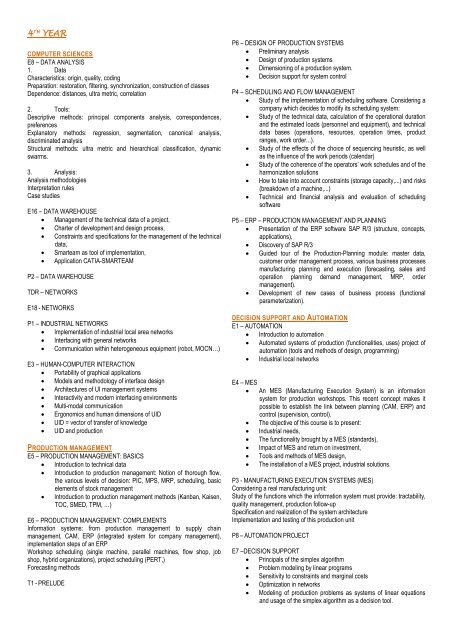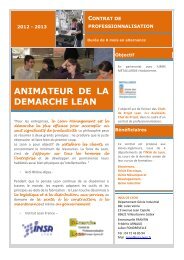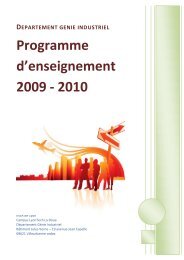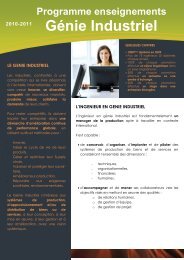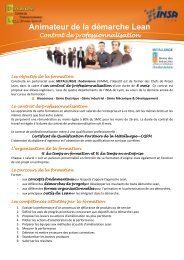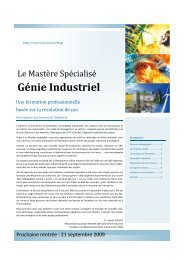Industrial Engineering Department - INSA de Lyon
Industrial Engineering Department - INSA de Lyon
Industrial Engineering Department - INSA de Lyon
Create successful ePaper yourself
Turn your PDF publications into a flip-book with our unique Google optimized e-Paper software.
4 TH YEAR<br />
COMPUTER SCIENCES<br />
E8 – DATA ANALYSIS<br />
1. Data<br />
Characteristics: origin, quality, coding<br />
Preparation: restoration, filtering, synchronization, construction of classes<br />
Depen<strong>de</strong>nce: distances, ultra metric, correlation<br />
2. Tools:<br />
Descriptive methods: principal components analysis, correspon<strong>de</strong>nces,<br />
preferences<br />
Explanatory methods: regression, segmentation, canonical analysis,<br />
discriminated analysis<br />
Structural methods: ultra metric and hierarchical classification, dynamic<br />
swarms.<br />
3. Analysis:<br />
Analysis methodologies<br />
Interpretation rules<br />
Case studies<br />
E16 – DATA WAREHOUSE<br />
Management of the technical data of a project,<br />
Charter of <strong>de</strong>velopment and <strong>de</strong>sign process,<br />
Constraints and specifications for the management of the technical<br />
data,<br />
Smarteam as tool of implementation,<br />
Application CATIA-SMARTEAM<br />
P2 – DATA WAREHOUSE<br />
TDR – NETWORKS<br />
E18 - NETWORKS<br />
P1 – INDUSTRIAL NETWORKS<br />
Implementation of industrial local area networks<br />
Interfacing with general networks<br />
Communication within heterogeneous equipment (robot, MOCN…)<br />
E3 – HUMAN-COMPUTER INTERACTION<br />
Portability of graphical applications<br />
Mo<strong>de</strong>ls and methodology of interface <strong>de</strong>sign<br />
Architectures of UI management systems<br />
Interactivity and mo<strong>de</strong>rn interfacing environments<br />
Multi-modal communication<br />
Ergonomics and human dimensions of UID<br />
UID = vector of transfer of knowledge<br />
UID and production<br />
PRODUCTION MANAGEMENT<br />
E5 – PRODUCTION MANAGEMENT: BASICS<br />
Introduction to technical data<br />
Introduction to production management: Notion of thorough flow,<br />
the various levels of <strong>de</strong>cision: PIC, MPS, MRP, scheduling, basic<br />
elements of stock management<br />
Introduction to production management methods (Kanban, Kaisen,<br />
TOC, SMED, TPM, …)<br />
E6 – PRODUCTION MANAGEMENT: COMPLEMENTS<br />
Information systems: from production management to supply chain<br />
management, CAM, ERP (integrated system for company management),<br />
implementation steps of an ERP<br />
Workshop scheduling (single machine, parallel machines, flow shop, job<br />
shop, hybrid organizations), project scheduling (PERT,)<br />
Forecasting methods<br />
T1 - PRELUDE<br />
P6 – DESIGN OF PRODUCTION SYSTEMS<br />
Preliminary analysis<br />
Design of production systems<br />
Dimensioning of a production system.<br />
Decision support for system control<br />
P4 – SCHEDULING AND FLOW MANAGEMENT<br />
Study of the implementation of scheduling software. Consi<strong>de</strong>ring a<br />
company which <strong>de</strong>ci<strong>de</strong>s to modify its scheduling system:<br />
Study of the technical data, calculation of the operational duration<br />
and the estimated loads (personnel and equipment), and technical<br />
data bases (operations, resources, operation times, product<br />
ranges, work or<strong>de</strong>r...).<br />
Study of the effects of the choice of sequencing heuristic, as well<br />
as the influence of the work periods (calendar)<br />
Study of the coherence of the operators’ work schedules and of the<br />
harmonization solutions<br />
How to take into account constraints (storage capacity,...) and risks<br />
(breakdown of a machine,...)<br />
Technical and financial analysis and evaluation of scheduling<br />
software<br />
P5 – ERP – PRODUCTION MANAGEMENT AND PLANNING<br />
Presentation of the ERP software SAP R/3 (structure, concepts,<br />
applications),<br />
Discovery of SAP R/3<br />
Gui<strong>de</strong>d tour of the Production-Planning module: master data,<br />
customer or<strong>de</strong>r management process, various business processes<br />
manufacturing planning and execution (forecasting, sales and<br />
operation planning <strong>de</strong>mand management, MRP, or<strong>de</strong>r<br />
management).<br />
Development of new cases of business process (functional<br />
parameterization).<br />
DECISION SUPPORT AND AUTOMATION<br />
E1 – AUTOMATION<br />
Introduction to automation<br />
Automated systems of production (functionalities, uses) project of<br />
automation (tools and methods of <strong>de</strong>sign, programming)<br />
<strong>Industrial</strong> local networks<br />
E4 – MES<br />
An MES (Manufacturing Execution System) is an information<br />
system for production workshops. This recent concept makes it<br />
possible to establish the link between planning (CAM, ERP) and<br />
control (supervision, control).<br />
The objective of this course is to present:<br />
<strong>Industrial</strong> needs,<br />
The functionality brought by a MES (standards),<br />
Impact of MES and return on investment,<br />
Tools and methods of MES <strong>de</strong>sign,<br />
The installation of a MES project, industrial solutions.<br />
P3 - MANUFACTURING EXECUTION SYSTEMS (MES)<br />
Consi<strong>de</strong>ring a real manufacturing unit:<br />
Study of the functions which the information system must provi<strong>de</strong>: tractability,<br />
quality management, production follow-up<br />
Specification and realization of the system architecture<br />
Implementation and testing of this production unit<br />
P8 – AUTOMATION PROJECT<br />
E7 –DECISION SUPPORT<br />
Principals of the simplex algorithm<br />
Problem mo<strong>de</strong>ling by linear programs<br />
Sensitivity to constraints and marginal costs<br />
Optimization in networks<br />
Mo<strong>de</strong>ling of production problems as systems of linear equations<br />
and usage of the simplex algorithm as a <strong>de</strong>cision tool.


